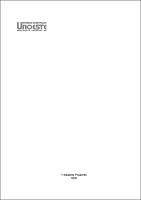| Compartilhamento |


|
Use este identificador para citar ou linkar para este item:
http://bdtd.unoeste.br:8080/jspui/handle/tede/959| Tipo do documento: | Dissertação |
| Título: | O educomunicador no ensino da leitura da publicidade televisiva |
| Título(s) alternativo(s): | Visual language and Critical Reading. Education and Television. The Reception of the Advertising Text. |
| Autor: | Trindade, Larissa Crepaldi  |
| Primeiro orientador: | Perez, Maria de Lourdes Zizi Trevizan |
| Primeiro membro da banca: | Capelo, Maria Regina Clivati |
| Segundo membro da banca: | Cabello, Ana Rosa Gomes |
| Resumo: | A presente dissertação, intitulada O Educomunicador no ensino da leitura da publicidade televisiva teve como objetivo identificar o processo de leitura do conteúdo publicitário televisivo, realizado por professores e alunos do ensino fundamental de uma escola particular de Presidente Prudente/SP, com o intuito de contribuir futuramente na formação e capacitação de professores nessa área de conhecimento. Considerando que a linguagem audiovisual faz parte do cotidiano das crianças desta geração, justificou-se a necessidade desta pesquisa, baseada na teoria semiótica de Charles Sanders Peirce, para uma interpretação dos signos produzidos pela linguagem publicitária e das suas estratégias para reforço das imagens e condução do leitor ao consumo. A opção teórica, com foco na educação, foi centrada em Vigotsky que aponta o desenvolvimento da criança como um produto do meio e de seu contato com os signos e seus significados. Esta dissertação contemplou uma análise documental de cinco campanhas publicitárias, direcionadas ao público infantil, com o intuito de fazer uma leitura da recepção baseada no repertório icônico da publicidade. De natureza qualitativa, teve como método de investigação o Estudo de Caso, que contou com um universo de pesquisa composto por 18 sujeitos no total, sendo 3 docentes de 2ª e 3ª séries do ensino fundamental e 15 alunos das mesmas séries. A entrevista e o grupo de discussão foram utilizados como instrumentos da coleta de dados que contou com questionários iniciais, a fim de conhecer os hábitos e conhecimentos dos sujeitos da pesquisa em relação à televisão e à publicidade; e posteriormente, questionários relacionados ao entendimento ou leitura que os sujeitos realizaram do conteúdo publicitário selecionado pela pesquisadora. Os resultados previstos e constatados ao longo da dissertação explicitam as relações encontradas entre a linguagem audiovisual, a leitura feita pelo corpo docente e seus reflexos no aprendizado dos alunos. Foi verificado e exposto como ocorre o processo da leitura crítica das imagens da televisão e até que ponto esse instrumento auxilia a educação na escola, a principal disseminadora do conhecimento. |
| Abstract: | To present dissertation, entitled. "Educomunicador in the teaching of the reading of the television publicity". It had as objective identifies the process of reading of the television advertising content accomplished by teachers and students of the fundamental teaching of a school peculiar of Presidente Prudente / SP, with the intention of contributing hereafter in the formation and teachers' training in that knowledge area. Considering that the audiovisual language is part of the daily of the children of this generation, justified the need of this research, based on Charles Sanders Peirce theory semiotics, for an interpretation of the signs produced by the advertising language and of their strategies for reinforcement of the images and transport of the reader to the consumption. The theoretical option, with focus in the education, it was centered in Vigotsky that points the child's development as a product of the middle and of his/her contact with the signs and their meanings. This dissertation contemplated a documental analysis of five campaigns advertising, addressed the infantile public, with the intention of doing a reading of the reception based on the repertoire icônico of the publicity. Qualitative nature, had as investigation method the Study of Case, that counted with a research universe composed by 18 subjects in the total, being 3 educational of 2nd and 3rd series of the fundamental teaching and 15 students of the same series.The interview and the discussion group were used as instruments of the collection of data that counted with initial questionnaires, in order to know the habits and knowledge of the subject of the research in relation to television and to the publicity; and later, questionnaires related to the understanding or reading that the subjects accomplished of the advertising content selected by the researcher.The foreseen results and verified along the dissertation explicitam the relationships found among the audiovisual language, the reading done by the faculty and their reflexes in the students' learning. It was verified and exposed as it happens the process of the critical reading of the images of television and to what extent that instrument aids the education in the school, the main disseminadora of the knowledge. |
| Palavras-chave: | Publicidade -- Aspectos sociais Linguagem Leitura crítica Comunicação e educação Televisão na educação Visual language and Critical Reading Education and Television The Reception of the Advertising Text |
| Área(s) do CNPq: | CNPQ::CIENCIAS HUMANAS::EDUCACAO |
| Idioma: | por |
| País: | BR |
| Instituição: | Universidade do Oeste Paulista |
| Sigla da instituição: | UNOESTE |
| Departamento: | Ciências Humanas |
| Programa: | Mestrado em Educação |
| Citação: | TRINDADE, Larissa Crepaldi. Visual language and Critical Reading. Education and Television. The Reception of the Advertising Text.. 2008. 142 f. Dissertação (Mestrado em Ciências Humanas) - Universidade do Oeste Paulista, Presidente Prudente, 2008. |
| Tipo de acesso: | Acesso Aberto |
| URI: | http://bdtd.unoeste.br:8080/tede/handle/tede/959 |
| Data de defesa: | 29-Abr-2008 |
| Aparece nas coleções: | Mestrado em Educação |
Arquivos associados a este item:
| Arquivo | Descrição | Tamanho | Formato | |
|---|---|---|---|---|
| Dissertacao.pdf | 647,56 kB | Adobe PDF |  Baixar/Abrir Pré-Visualizar |
Os itens no repositório estão protegidos por copyright, com todos os direitos reservados, salvo quando é indicado o contrário.




